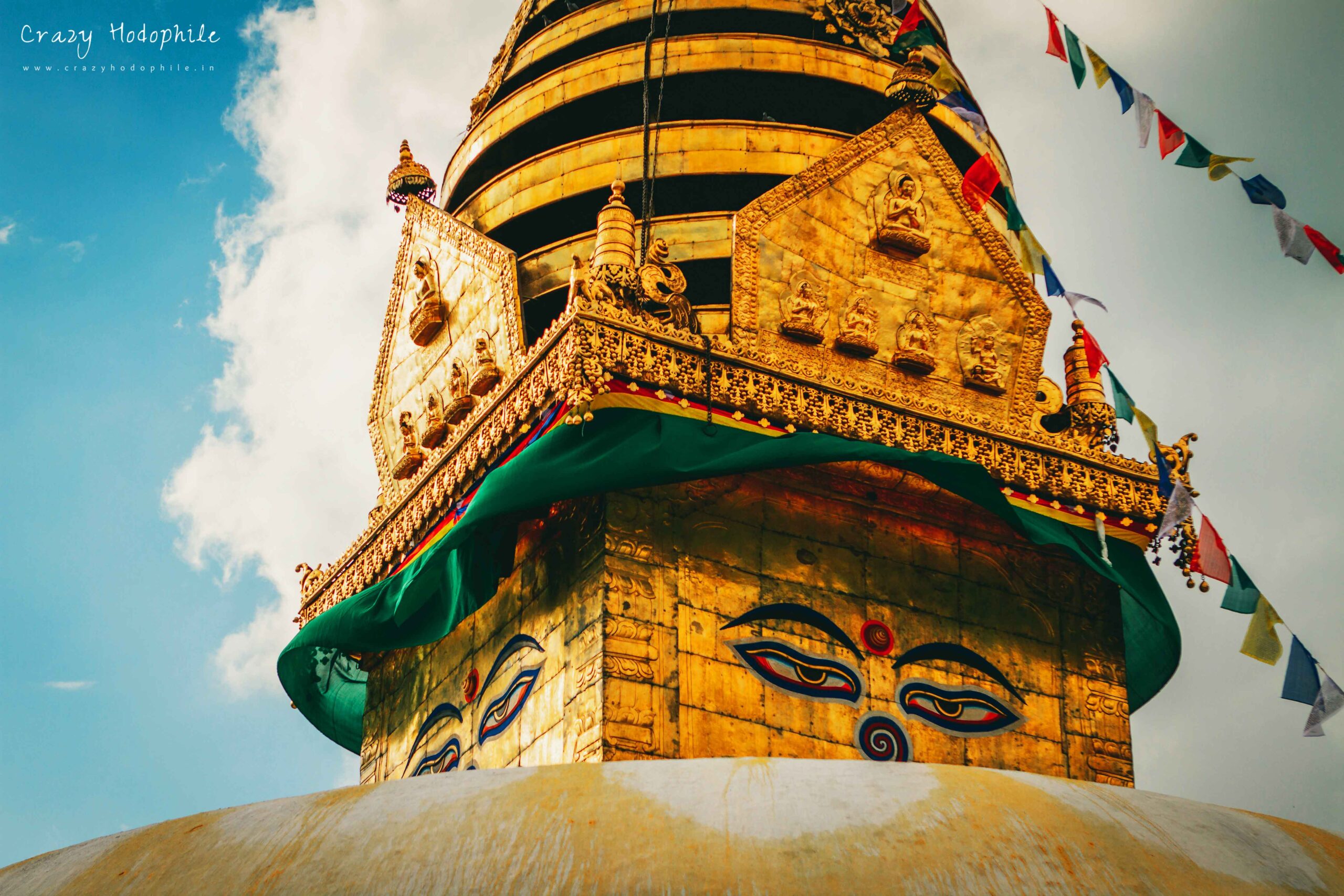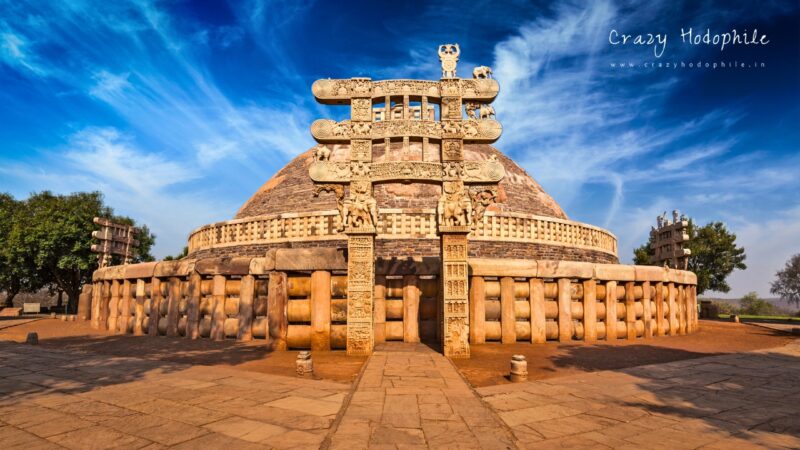Swayambhunath: The Ancient Marvel of Kathmandu | Crazy Hodophile | 2025
Swayambhunath is an ancient religious complex, nestled atop a hill in the vibrant city of Kathmandu, Nepal that holds immense significance for Buddhists and Hindus. This revered site, also affectionately known as the Monkey Temple, is a must-visit destination for anyone exploring the rich cultural tapestry of Nepal.
Table of Contents
Overview
Swayambhunath is a unique sanctuary where the spiritual traditions of Buddhism and Hinduism converge. The complex is home to various temples, shrines, and stupas dedicated to deities from both religions. This harmonious blend of beliefs creates an atmosphere of deep reverence and peaceful coexistence, making Swayambhunath a fascinating place to explore and reflect. Some notable structures include:
-
- The Iconic Stupa – At the heart of Swayambhunath stands its iconic stupa, one of Nepal’s oldest and most significant religious monuments. This stupa is considered a symbol of enlightenment and wisdom. Pilgrims and visitors alike can be seen circling the stupa, spinning prayer wheels, and offering prayers.
- Harati Temple – Also known as the Ajima Temple, it is dedicated to the goddess Harati, who is revered for her protective and healing powers, especially over children. The temple is a small, pagoda-style structure situated within the Swayambhunath complex. This sacred site attracts parents seeking blessings and health for their little ones.
- Shantipur – Shantipur, also known as the “Palace of Peace,” is a small temple within the Swayambhunath complex where tantric rituals are performed.
- Pratappur and Anantapur – These twin Shikhar-style temples, built by King Pratap Malla in the 17th century, are notable for their intricate architecture and provide stunning views of the Kathmandu Valley from Swayambhunath.
- Amideva Buddha Park – The park, located at the base of Swayambhunath, houses a large statue of Buddha along with two other statues. This statue is one of the three large statues in the park, representing one of the past Buddhas. The park and its statues serve as a peaceful area for meditation and offer a picturesque view of the surroundings.
- Statue of Dipankar Buddha – The statue of Dipankar Buddha is located in the Amideva Buddha Park. This statue, along with the statues of Shakyamuni Buddha and Maitreya Buddha, is one of the three large golden statues in the park. Dipankar Buddha is one of the Buddhas of the past, and the statue is a significant attraction for visitors and pilgrims.

Architectural Style
The architectural style of Swayambhunath is a harmonious blend of traditional Nepali and Tibetan influences. The stupa’s white dome and gilded spire, adorned with the all-seeing eyes of Buddha, are prominent landmarks visible from miles away. The spire consists of thirteen tiers, representing the stages that lead to nirvana. Surrounding the stupa are numerous shrines, temples, and prayer wheels, which enhance the site’s spiritual ambiance.

Opening and Closing
Swayambhunath is open 24 hours a day, offering unparalleled flexibility for visitors. Whether you prefer the tranquility of early morning, the vibrancy of the afternoon, or the serene ambiance of nighttime, you can explore this sacred site at your convenience.

Best Time to Visit
The best time to visit Swayambhunath is during the spring (February to March) and autumn (September to November) when the weather is pleasant, and the skies are clear.

Entrance Fee
- Entrance fee for Nepal Citizens: Free
- Entrance fee for SAARC Nationals: NPR 50
- Entrance fee for Foreign Nationals: NPR 200
Suggestion: Before planning your visit, please note that entrance charges can vary. To ensure you have the most accurate information, we recommend checking the official website for the latest entry fees.
For your convenience, here is the link to the official website: https://ntb.gov.np/en/plan-your-trip/before-you-come/heritage-site-entry-fees

Dos and Don’ts
- Do: Respect the sacredness of the site by dressing modestly and behaving respectfully.
- Don’t: Feed or provoke the monkeys, as they can become aggressive.
- Do: Remove your shoes before entering the temple complex.
- Don’t: Litter or deface the monuments; help preserve the site for future generations.
- Do: Walk around the stupa in a clockwise direction as a sign of respect.
- Don’t: Take photos inside the temples without permission.
Suggestion: We recommend checking with authorities or on-site signage for any specific restrictions or guidelines regarding photography and videography.
History
The origins of Swayambhunath are shrouded in myth and legend. According to legend, the Kathmandu Valley was once a large lake, and the hill where Swayambhunath stands emerged spontaneously when the lake was drained by the Bodhisattva Manjushri.
The Bodhisattva Manjushri in a divine act, cut a gorge at Chovar with his sword, draining the lake and revealing the valley. The lotus flower settled on top of the hill, and a radiant light emanated from it, which is said to be the origin of the stupa. The site has been a pilgrimage destination for centuries, with the stupa being established around the 5th century AD.
Historical texts like the Gopalarajavamsavali attribute its founding to King Vrsadeva, the great-grandfather of King Manadeva (464–505 CE) in the Licchavi period, around the early fifth century CE. A damaged stone inscription discovered at the site suggests King Manadeva initiated construction work in 640 CE.
Cultural Significance
Swayambhunath, also known as the Monkey Temple, holds immense cultural and religious significance for both Buddhists and Hindus. Here’s a deeper look into the cultural importance of Swayambhunath:
- Buddhist Significance: Swayambhunath is one of the oldest and most sacred Buddhist sites in Nepal. It is believed to have been established over 2000 years ago and holds a central place in Newar Buddhism, which is practiced by the Newar people of the Kathmandu Valley. The stupa’s eyes, known as “Buddha’s eyes,” symbolize wisdom and compassion, reflecting the core teachings of Buddhism.
- Hindu Significance: While primarily a Buddhist site, Swayambhunath is also revered by Hindus. The presence of Hindu deities and shrines within the complex highlights the intermingling of the two religions in Nepal. This harmonious coexistence is a testament to the cultural and religious syncretism that characterizes the region.
- Community and Heritage: The site is also a center for community gatherings and cultural activities. It plays a vital role in preserving and promoting the traditional customs, rituals, and artistic heritage of the Newar community. Pilgrims and visitors from around the world flock to the site to pay their respects, spin prayer wheels, and soak in the spiritual ambiance. The resident monkeys, considered sacred, add to the charm and mystique of the place.
- Swayambhu Purana: The Swayambhu Purana is a Buddhist scripture detailing the origin and development of the Kathmandu Valley. This sacred text provides comprehensive accounts of all the Buddhas who have visited Kathmandu. Additionally, it offers insights into the first and second Buddhas in Buddhism.
1346 AD Destruction
In the 14th century, the Swayambhunath stupa suffered significant damage at the hands of Sultan Shamsuddin Ilyas Shah of Bengal. His forces invaded the Kathmandu Valley around 1346 AD, during which several temples and religious structures, including Swayambhunath and Pashupatinath Temple, were damaged or destroyed. Additionally, the city of Kathmandu was looted for three days. This destruction was part of a broader campaign to assert dominance and spread Islam in the region.
Renovation and Development
Over the centuries, various rulers and patrons have contributed to the development and renovation of the complex. The complex saw significant additions, including numerous temples, shrines, and prayer wheels, reflecting the blend of Buddhist and Hindu traditions that characterize the site today. Here are some of the key contributors:
- King Vrsadeva (5th Century CE): King Vrsadeva is credited with the initial construction of the Swayambhunath stupa in the 4th century. His contributions laid the foundational structure that has remained central to the complex.
- King Manadeva (Licchavi Dynasty): King Manadeva is known for commissioning important renovations and further developments to the Swayambhunath complex. His reign saw the addition of key architectural features that enhanced the stupa’s spiritual and cultural significance.
- King Sthiti Malla (late 14th century): After the destruction caused by Sultan Shamsuddin Ilyas Shah in the 14th century, King Sthiti Malla, who ruled the Kathmandu Valley in the late 14th century, is credited with initiating the repair and restoration of Swayambhunath. His efforts helped to restore the stupa and surrounding structures, ensuring the complex remained a vital religious site.
- King Pratap Malla (17th Century): King Pratap Malla is recognized for his efforts in restoring and beautifying the stupa and its surroundings. He added several inscriptions and constructed the eastern stairway.
- Rana Dynasty (19th to 20th Century): The Rana rulers, particularly during the 19th century, focused on preserving and maintaining Swayambhunath. They undertook restoration projects to repair damages caused by natural wear and calamities, ensuring the site remained intact for future generations.
- 2010 Renewal: In 2010, significant restoration work was undertaken at Swayambhunath to address the wear and damage accumulated over the years. This restoration effort focused on several key aspects: Structural Repairs, Conservation Efforts, and Artistic Restoration.
- 2015 Renewal: The 2015 restoration efforts were particularly significant due to the devastating earthquake that struck Nepal on April 25, 2015. The earthquake caused extensive damage to many historical and cultural sites in the Kathmandu Valley, including Swayambhunath.
Recognition and Preservation
Swayambhunath was designated a UNESCO World Heritage Site in 1979, recognizing its cultural and religious significance. Efforts have been made to preserve and protect the site, including restoration work and measures to manage tourism sustainably.
How to Reach
- Tribhuvan International Airport (Kathmandu) is the nearest airport, located approximately 10 km from Swayambhunath. From the airport, you can hire a taxi or use a ride-sharing service to reach there.
- Taxi/Ride-sharing Services: Taxi and ride-sharing services like Pathao and Tootle are available throughout Kathmandu but tend to be more expensive.
- Public Transport: For a more economical option, consider using public buses and microbuses that frequently run routes to Swayambhu from various parts of Kathmandu. You can ask locals or bus operators for the specific bus number or route that goes to Swayambhu.
Location Map for Swayambhunath Stupa
What’s Worth Seeing Near Swayambhunath Stupa
- Swayambhu Buddhist Museum (150 m): Located within the Swayambhunath complex, offers a rich collection of artifacts and exhibits showcasing the history and cultural heritage of Buddhism in Nepal.
- Kathmandu Durbar Square (2.2 km): A historic square filled with palaces, courtyards, and temples, situated in the heart of Kathmandu.
- Thamel (2.9 km): A bustling neighborhood renowned for its shops, restaurants, and vibrant nightlife. Thamel is a popular destination for tourists seeking local crafts, souvenirs, and an eclectic culinary experience.
- Garden of Dreams (3.3 km): A serene and beautifully landscaped garden located in central Kathmandu. The Garden of Dreams offers a peaceful retreat from the city’s hustle and bustle, perfect for relaxation and reflection.
- Pashupatinath Temple (7.5 km): A sacred Hindu temple dedicated to Lord Shiva, located on the banks of the Bagmati River. Pashupatinath Temple is a major pilgrimage site for Hindus and is known for its intricate architecture and spiritual ambiance.
- Boudhanath Stupa (10 km): One of the largest stupas in Nepal and another important pilgrimage site for Buddhists. Boudhanath Stupa is a stunning architectural marvel and a center of Tibetan culture in Kathmandu.
Photo Credits:
Featured Image Credits – Raimond Klavins
References:
(a) Wikipedia




Amazingly presented
Thanks Debjani